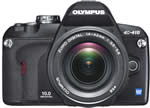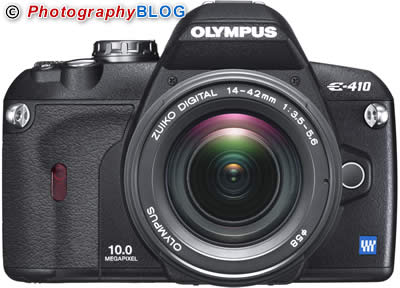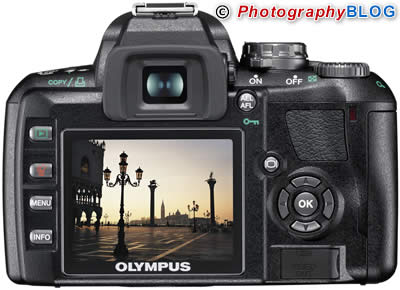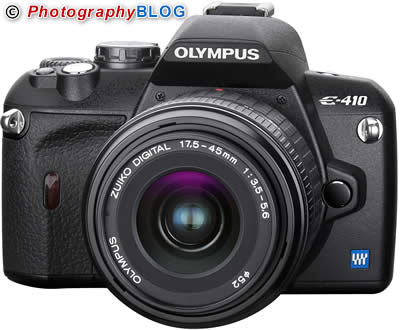Olympus E-410
 PMA 2007: The Olympus E-410 is one of the world’s most compact DSLR cameras with Live Preview. Based on the Four Thirds Standard, the Olympus E-410 replaces the E-400 and features a a new, professional-grade 10 megapixel Live MOS sensor. There’s also a new image processing engine which provides sequential shooting at up to 3fps with a seven image RAW buffer in burst mode. Both CompactFlash and xD-Picture Cards can be used with the E410, whilst you can use either the optical viewfinder or the 2.5 inch LCD to frame your shot. The new Olympus E-410 will be available from June 2007 for around £500 body only, £600 in a kit with the 14-42mm lens, and £700 with the 14-42mm and 40-150mm lenses.
PMA 2007: The Olympus E-410 is one of the world’s most compact DSLR cameras with Live Preview. Based on the Four Thirds Standard, the Olympus E-410 replaces the E-400 and features a a new, professional-grade 10 megapixel Live MOS sensor. There’s also a new image processing engine which provides sequential shooting at up to 3fps with a seven image RAW buffer in burst mode. Both CompactFlash and xD-Picture Cards can be used with the E410, whilst you can use either the optical viewfinder or the 2.5 inch LCD to frame your shot. The new Olympus E-410 will be available from June 2007 for around £500 body only, £600 in a kit with the 14-42mm lens, and £700 with the 14-42mm and 40-150mm lenses.
Olympus UK Press Release
Great things come in small packages
The Olympus E-410: The incredibly compact and lightweight D-SLR with Live Preview capability
London, 5 March 2007 – Extraordinary compactness, leading-edge technology and brilliant performance distinguish the new Olympus E-410 from the competition. This successor to the E-400 is one of the world’s most compact D-SLRs with Live Preview. Photographers benefit from exceptional mobility and are not limited to only looking through the viewfinder when framing compositions – as is the case in most D-SLRs – but can frame their subject directly on the large 2.5”/6.4cm HyperCrystal LCD. Thanks to compatibility with the Four Thirds Standard, a supreme selection of lenses and other accessories is at the disposal of users, extending the potential areas of application. Meanwhile, a new, professional-grade Live MOS sensor delivers 10 Megapixels of high-definition image recording under all conditions. Also new is the image processing engine which features excellent noise performance. It dramatically boosts shooting results and further perfects quality. And naturally, as with all E-System cameras from the inventor of dust-free D-SLR photography, the Olympus E-410 incorporates the patented Supersonic Wave Filter. This ensures that users never need to worry about the harmful effects dust can have on their images.
Exceptional compactness and cutting-edge technology
One of the smallest and lightest D-SLRs with Live Preview in the world, the E-410 gives photographers a decisive advantage. Matched with a range of ultra-compact lenses, this camera allows for virtually unimpeded mobility. It is therefore ideal for taking along on trips, holidays, photo assignments, for that matter, to just about any shooting situation where a large, bulky camera set-up might compromise the photo opportunities.
The Live Preview function is available for shots with both auto focus (AF) and manual focusing (MF), allowing scenes being framed to be viewed directly on the 2.5”/6.4cm HyperCrystal LCD. The AF function is enabled by simply pressing the AEL/AFL button, which prompts the mirror to fold down momentarily and then quickly pop back up again once the AF measurement has been made. The MF option, meanwhile, allows for superior focusing accuracy as images on the LCD can be enlarged by 6x or 10x. It is therefore ideally suited for macro shooting.
In the development of this camera, particular emphasis was placed on boosting performance and further reducing image noise. By incorporating a new image processing engine and sensor, this latest Olympus model produces sensationally clear 10 Megapixel results with accurate colour reproduction, and can boast faster processing speeds, as well as low power consumption. Sequential shooting at up to 3fps with a seven image RAW buffer in burst mode is also possible.
Superior handling
The E-410 meets just about every professional demand, yet it also proves that high performance needn’t mean difficult operation. In addition to offering an abundance of adjustable exposure options, including full manual control for unlimited creative freedom, 32 consumer-friendly shooting modes are on board for ease-of-use in all manner of situations. These range from Portrait and Macro to Underwater Wide, Underwater Macro and xD Panorama. Meanwhile, photographers can make use of various colour modes and Black&White filters. What’s more, Live Preview functionality allows users to preview and manage tedious adjustments such as exposure and WB compensation right on the LCD – so photographers can revel in the unique comfort and control this added convenience affords them.
Users have a choice of data storage options: both CompactFlash and xD-Picture Cards can be used with the E-410, which allows even those upgrading from Olympus compact cameras to continue using their existing cards. And to ensure accessibility across the entire European continent, ten languages are on board and a further 15 can be downloaded if desired.
With the intuitive placement of buttons and controls, photographers will feel at home with the E-410 in no time. Info screens can be selected to show full advanced information or just the basics, making it very user-friendly, even for beginners. And ensuring quick data transfer between camera and computer, Hi-Speed USB is supported with up to 480 MBit/s.
Wide range of accessories
Users benefit from nearly boundless versatility when choosing accessories for their E-410 thanks to compatibility with the Four Thirds System. This standard is supported by a growing number of companies and ensures full cross-manufacturer compatibility of lenses. In addition, almost the complete line-up of E-System accessories can be used with this model. This includes first-class, near telecentric lense that cover the full scope of focal ranges from fisheye to ultrazoom. Since Four Thirds Standard lenses are built specifically for the rigorous demands of digital photography, they can achieve higher-aperture shots without being as big and bulky as their non-Four Thirds counterparts. The E-410 also comes equipped with a long-lasting rechargeable battery that will ensure power requirements are met – even if the shoot goes into overtime. And for capturing beautiful scenes up to 40m below the water’s surface, the Underwater Case PT-E03 is available. When it comes to those underwater shots, count on bright Live Preview to make the experience even more rewarding. Get a better and more accurate view of compositions before you shoot them – and take the guesswork out of D-SLR underwater photography.
As one of the world’s most compact D-SLRs. The E-410 boasts two very convincing arguments. Matched with a high-performance image sensor and a fast new image engine featuring outstanding noise characteristics, ambitious photographers can look forward to superior picture quality and excellent handling that exceeds their expectations – while retaining amazing mobility. This intriguing member of the E-System family will be available from June 2007.
The Olympus E-410 digital SLR – main features:
• Light and compact with Live Preview
• 10 Megapixel Live MOS sensor
• New image processing engine
• Hi-Speed USB 2.0
• 2.5”/6.4cm HyperCrystal LCD
• Supersonic Wave Filter for dust protection
• Dual memory card slots (for xD-Picture Card and CompactFlash)
• 32 shooting modes (incl. 5 exposure, 7 creative & 20 scene modes)
• Built-in pop-up flash (GN 10)
• 3fps with up to seven images in RAW buffer
• One touch white balance
• AF-lock functionality
• Depth of field preview function
• 49 segment digital ESP
• Exposure bracketing function
• Beginners’ and advanced info screen
• Detailed playback info screen with histogram
• Based on Four Thirds Standard
• Optional Underwater Case (PT-E03) available
Olympus E-System lens line-up*:
Top Pro lens range
• ZUIKO DIGITAL ED 7-14mm (14-28mm) 1:4.0
• ZUIKO DIGITAL ED 35-100mm (70-200mm) 1:2.0
• ZUIKO DIGITAL ED 90-250mm (180-500mm) 1:2.8
• ZUIKO DIGITAL ED 150mm (300mm) 1:2.0
• ZUIKO DIGITAL ED 300mm (600mm) 1:2.8
Pro lens range
• ZUIKO DIGITAL 11-22mm (22-44mm) 1:2.8-3.5
• ZUIKO DIGITAL 14-54mm (28-108mm) 1:2.8-3.5
• ZUIKO DIGITAL ED 50-200mm (100-400mm) 1:2.8-3.5
• ZUIKO DIGITAL ED 8mm (16mm) 1:3.5 Fisheye
• ZUIKO DIGITAL ED 50mm (100mm) 1:2.0 Macro
Standard lens range
• ZUIKO DIGITAL ED 14-42mm (28-84mm) 1:3.5-5.6
• ZUIKO DIGITAL 14-45mm (28-90mm) 1:3.5-5.6
• ZUIKO DIGITAL ED 18-180mm (36-360mm) 1:3.5-6.3
• ZUIKO DIGITAL 40-150mm (80-300mm) 1:3.5-4.5
• Extra compact ZUIKO DIGITAL ED 40-150mm (80-300mm) 1:4.0-5.6
• ZUIKO DIGITAL 35mm Macro (70mm) 1:3.5
* Figures in brackets show 35mm camera equivalents
Appendix
Four Thirds System
This is the first and currently only open standard for digital SLRs. As the name suggests, Four Thirds systems use a 4/3-type image sensor, the size of which allows the development of tailor-made interchangeable lenses. These are not only smaller and lighter, but also offer a greater light-gathering power than lenses based on the 35mm film format. Besides Olympus, current members of the Four Thirds consortium include Kodak, Fuji, Sanyo, Sigma, Panasonic and Leica.
Live Preview
Live Preview provides an alternative to framing shots through the viewfinder on a digital SLR camera. The image sent through the lens to the image sensor is displayed directly on the camera’s LCD. Whereas most compact digital cameras have been equipped with Live Preview functionality for many years, this feature has only recently become available on D-SLRs. The world’s first D-SLR to feature continuous Live Previews was the Olympus E-330.
Supersonic Wave Filter
Dust entering digital SLRs, for example during lens changes, can cause damage to photos – unless it is removed. With the Supersonic Wave Filter, the potential for dust to ruin photos is eliminated. A transparent filter is located between the camera’s shutter and CCD. It makes sure no dust is able to land on the CCD. Instead, the particles settle on the filter and are then shaken off by a series of ultrasonic vibrations generated by the filter when activated. Olympus was the first manufacturer to incorporate dust protection in D-SLRs.
HyperCrystal LCD
A semi-transmissive technology used in LCDs, which employs an additional layer at the bottom of the LCD to reflect light from external light sources. This enhances the brightness of the LCD, so even in direct sunlight images are displayed sharply and with three times the contrast of conventional displays. Also, it provides for viewing angles of up to 170° without glare or shadow, so images can be framed from a variety of angles and viewed by several people at once.




Loading comments…